Governance in Globalization: Theories, Practices, and Impact
VerifiedAdded on 2020/05/01
|9
|2553
|472
Essay
AI Summary
This essay delves into the multifaceted aspects of governance within the context of globalization. It begins by emphasizing the importance of organizational management, highlighting the need for strict procedures and professional conduct, while also addressing the significance of adapting management to avoid complacency. The essay then examines the Agency and Stewardship theories, offering insights into organizational management dynamics and the behavioral perspectives that influence management activities. The discussion extends to board diversity, exploring the imposition of quotas as a means to improve representation, particularly in Norway. Furthermore, the role of trade unions and activism in transforming global labor situations is analyzed, with a focus on protecting employee rights and the application of the Stakeholder and Stewardship theories in these contexts. The essay underscores the significance of human rights protection and the role of activists and trade unions in advocating for employees' interests, as well as the relationship between employees and employers within the framework of organizational stakeholders.
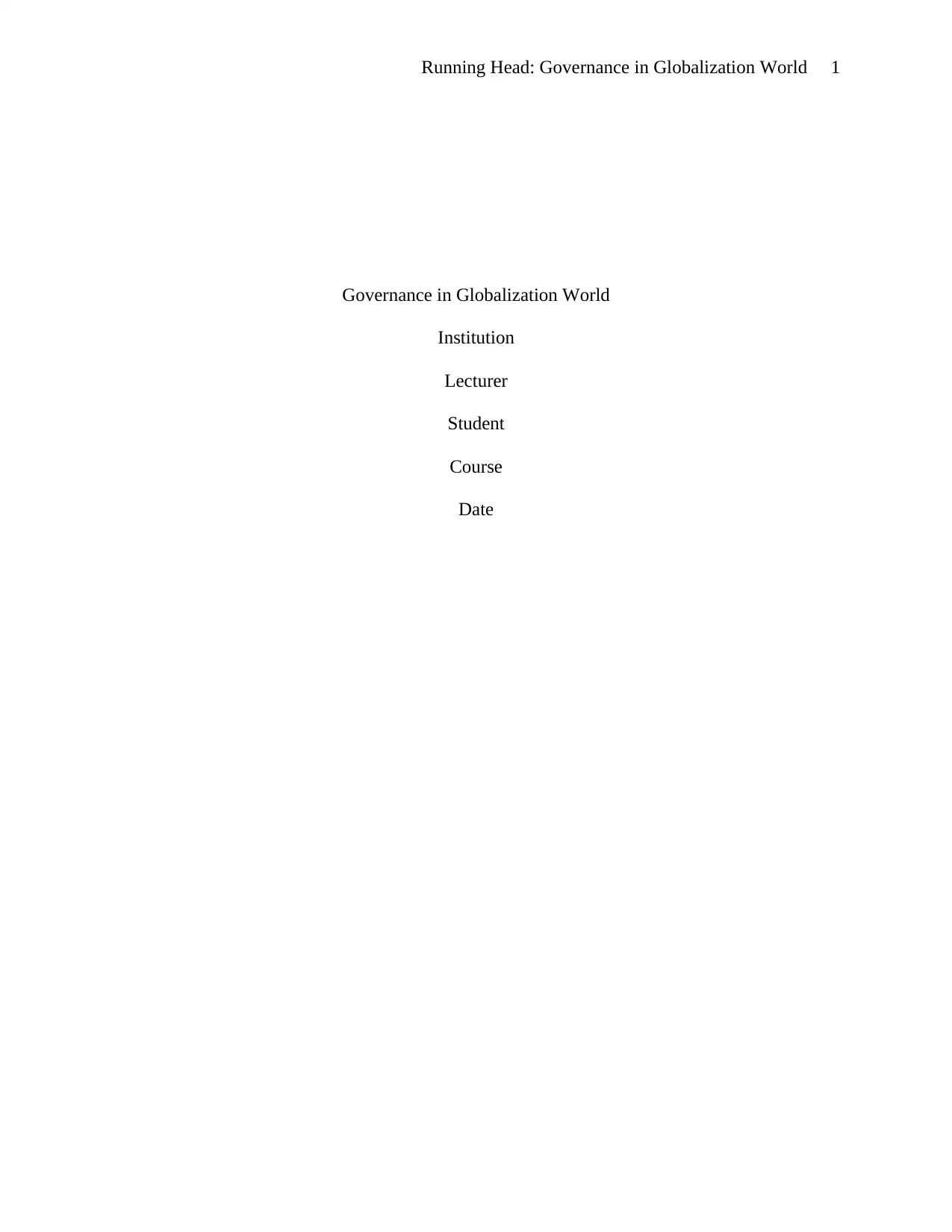
Running Head: Governance in Globalization World 1
Governance in Globalization World
Institution
Lecturer
Student
Course
Date
Governance in Globalization World
Institution
Lecturer
Student
Course
Date
Paraphrase This Document
Need a fresh take? Get an instant paraphrase of this document with our AI Paraphraser
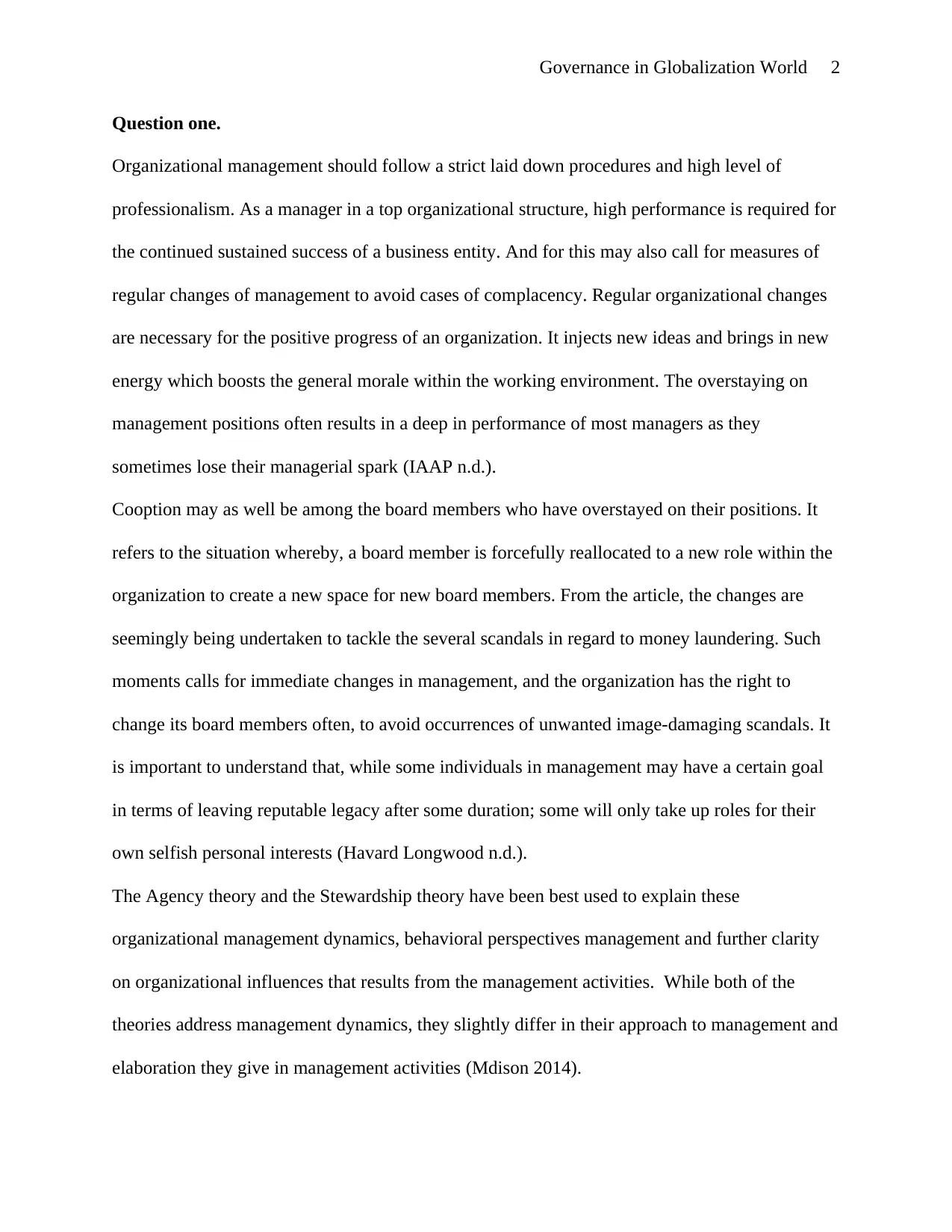
Governance in Globalization World 2
Question one.
Organizational management should follow a strict laid down procedures and high level of
professionalism. As a manager in a top organizational structure, high performance is required for
the continued sustained success of a business entity. And for this may also call for measures of
regular changes of management to avoid cases of complacency. Regular organizational changes
are necessary for the positive progress of an organization. It injects new ideas and brings in new
energy which boosts the general morale within the working environment. The overstaying on
management positions often results in a deep in performance of most managers as they
sometimes lose their managerial spark (IAAP n.d.).
Cooption may as well be among the board members who have overstayed on their positions. It
refers to the situation whereby, a board member is forcefully reallocated to a new role within the
organization to create a new space for new board members. From the article, the changes are
seemingly being undertaken to tackle the several scandals in regard to money laundering. Such
moments calls for immediate changes in management, and the organization has the right to
change its board members often, to avoid occurrences of unwanted image-damaging scandals. It
is important to understand that, while some individuals in management may have a certain goal
in terms of leaving reputable legacy after some duration; some will only take up roles for their
own selfish personal interests (Havard Longwood n.d.).
The Agency theory and the Stewardship theory have been best used to explain these
organizational management dynamics, behavioral perspectives management and further clarity
on organizational influences that results from the management activities. While both of the
theories address management dynamics, they slightly differ in their approach to management and
elaboration they give in management activities (Mdison 2014).
Question one.
Organizational management should follow a strict laid down procedures and high level of
professionalism. As a manager in a top organizational structure, high performance is required for
the continued sustained success of a business entity. And for this may also call for measures of
regular changes of management to avoid cases of complacency. Regular organizational changes
are necessary for the positive progress of an organization. It injects new ideas and brings in new
energy which boosts the general morale within the working environment. The overstaying on
management positions often results in a deep in performance of most managers as they
sometimes lose their managerial spark (IAAP n.d.).
Cooption may as well be among the board members who have overstayed on their positions. It
refers to the situation whereby, a board member is forcefully reallocated to a new role within the
organization to create a new space for new board members. From the article, the changes are
seemingly being undertaken to tackle the several scandals in regard to money laundering. Such
moments calls for immediate changes in management, and the organization has the right to
change its board members often, to avoid occurrences of unwanted image-damaging scandals. It
is important to understand that, while some individuals in management may have a certain goal
in terms of leaving reputable legacy after some duration; some will only take up roles for their
own selfish personal interests (Havard Longwood n.d.).
The Agency theory and the Stewardship theory have been best used to explain these
organizational management dynamics, behavioral perspectives management and further clarity
on organizational influences that results from the management activities. While both of the
theories address management dynamics, they slightly differ in their approach to management and
elaboration they give in management activities (Mdison 2014).
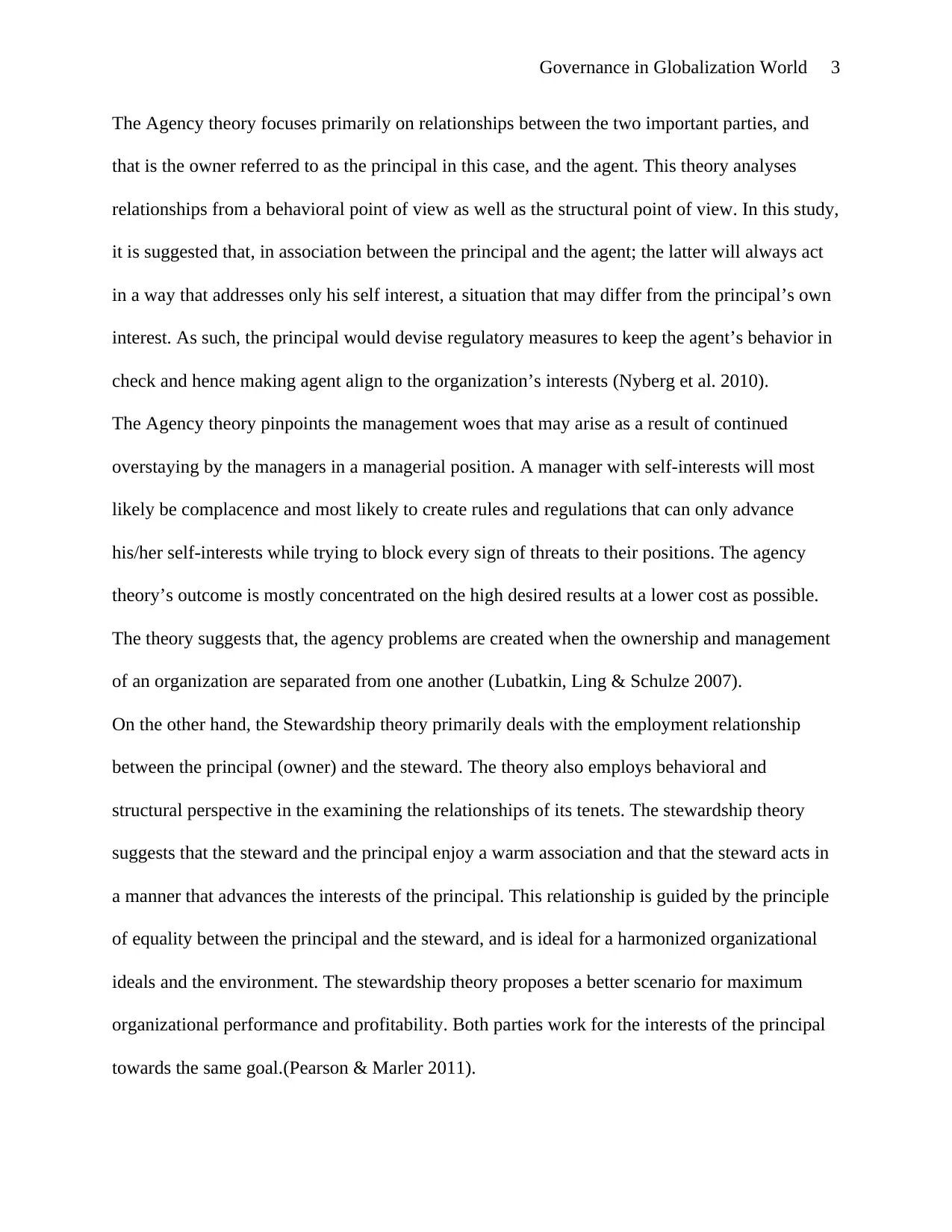
Governance in Globalization World 3
The Agency theory focuses primarily on relationships between the two important parties, and
that is the owner referred to as the principal in this case, and the agent. This theory analyses
relationships from a behavioral point of view as well as the structural point of view. In this study,
it is suggested that, in association between the principal and the agent; the latter will always act
in a way that addresses only his self interest, a situation that may differ from the principal’s own
interest. As such, the principal would devise regulatory measures to keep the agent’s behavior in
check and hence making agent align to the organization’s interests (Nyberg et al. 2010).
The Agency theory pinpoints the management woes that may arise as a result of continued
overstaying by the managers in a managerial position. A manager with self-interests will most
likely be complacence and most likely to create rules and regulations that can only advance
his/her self-interests while trying to block every sign of threats to their positions. The agency
theory’s outcome is mostly concentrated on the high desired results at a lower cost as possible.
The theory suggests that, the agency problems are created when the ownership and management
of an organization are separated from one another (Lubatkin, Ling & Schulze 2007).
On the other hand, the Stewardship theory primarily deals with the employment relationship
between the principal (owner) and the steward. The theory also employs behavioral and
structural perspective in the examining the relationships of its tenets. The stewardship theory
suggests that the steward and the principal enjoy a warm association and that the steward acts in
a manner that advances the interests of the principal. This relationship is guided by the principle
of equality between the principal and the steward, and is ideal for a harmonized organizational
ideals and the environment. The stewardship theory proposes a better scenario for maximum
organizational performance and profitability. Both parties work for the interests of the principal
towards the same goal.(Pearson & Marler 2011).
The Agency theory focuses primarily on relationships between the two important parties, and
that is the owner referred to as the principal in this case, and the agent. This theory analyses
relationships from a behavioral point of view as well as the structural point of view. In this study,
it is suggested that, in association between the principal and the agent; the latter will always act
in a way that addresses only his self interest, a situation that may differ from the principal’s own
interest. As such, the principal would devise regulatory measures to keep the agent’s behavior in
check and hence making agent align to the organization’s interests (Nyberg et al. 2010).
The Agency theory pinpoints the management woes that may arise as a result of continued
overstaying by the managers in a managerial position. A manager with self-interests will most
likely be complacence and most likely to create rules and regulations that can only advance
his/her self-interests while trying to block every sign of threats to their positions. The agency
theory’s outcome is mostly concentrated on the high desired results at a lower cost as possible.
The theory suggests that, the agency problems are created when the ownership and management
of an organization are separated from one another (Lubatkin, Ling & Schulze 2007).
On the other hand, the Stewardship theory primarily deals with the employment relationship
between the principal (owner) and the steward. The theory also employs behavioral and
structural perspective in the examining the relationships of its tenets. The stewardship theory
suggests that the steward and the principal enjoy a warm association and that the steward acts in
a manner that advances the interests of the principal. This relationship is guided by the principle
of equality between the principal and the steward, and is ideal for a harmonized organizational
ideals and the environment. The stewardship theory proposes a better scenario for maximum
organizational performance and profitability. Both parties work for the interests of the principal
towards the same goal.(Pearson & Marler 2011).
⊘ This is a preview!⊘
Do you want full access?
Subscribe today to unlock all pages.

Trusted by 1+ million students worldwide
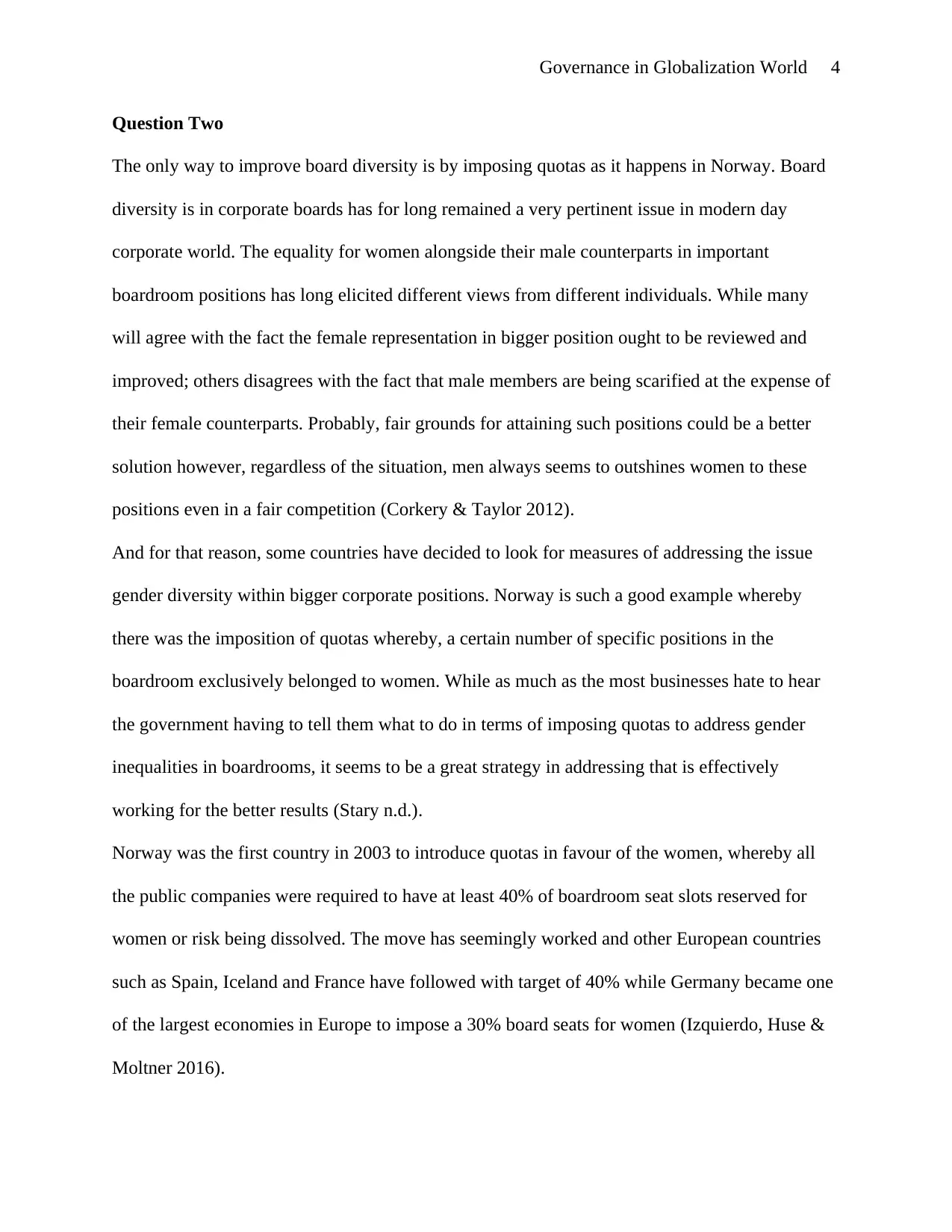
Governance in Globalization World 4
Question Two
The only way to improve board diversity is by imposing quotas as it happens in Norway. Board
diversity is in corporate boards has for long remained a very pertinent issue in modern day
corporate world. The equality for women alongside their male counterparts in important
boardroom positions has long elicited different views from different individuals. While many
will agree with the fact the female representation in bigger position ought to be reviewed and
improved; others disagrees with the fact that male members are being scarified at the expense of
their female counterparts. Probably, fair grounds for attaining such positions could be a better
solution however, regardless of the situation, men always seems to outshines women to these
positions even in a fair competition (Corkery & Taylor 2012).
And for that reason, some countries have decided to look for measures of addressing the issue
gender diversity within bigger corporate positions. Norway is such a good example whereby
there was the imposition of quotas whereby, a certain number of specific positions in the
boardroom exclusively belonged to women. While as much as the most businesses hate to hear
the government having to tell them what to do in terms of imposing quotas to address gender
inequalities in boardrooms, it seems to be a great strategy in addressing that is effectively
working for the better results (Stary n.d.).
Norway was the first country in 2003 to introduce quotas in favour of the women, whereby all
the public companies were required to have at least 40% of boardroom seat slots reserved for
women or risk being dissolved. The move has seemingly worked and other European countries
such as Spain, Iceland and France have followed with target of 40% while Germany became one
of the largest economies in Europe to impose a 30% board seats for women (Izquierdo, Huse &
Moltner 2016).
Question Two
The only way to improve board diversity is by imposing quotas as it happens in Norway. Board
diversity is in corporate boards has for long remained a very pertinent issue in modern day
corporate world. The equality for women alongside their male counterparts in important
boardroom positions has long elicited different views from different individuals. While many
will agree with the fact the female representation in bigger position ought to be reviewed and
improved; others disagrees with the fact that male members are being scarified at the expense of
their female counterparts. Probably, fair grounds for attaining such positions could be a better
solution however, regardless of the situation, men always seems to outshines women to these
positions even in a fair competition (Corkery & Taylor 2012).
And for that reason, some countries have decided to look for measures of addressing the issue
gender diversity within bigger corporate positions. Norway is such a good example whereby
there was the imposition of quotas whereby, a certain number of specific positions in the
boardroom exclusively belonged to women. While as much as the most businesses hate to hear
the government having to tell them what to do in terms of imposing quotas to address gender
inequalities in boardrooms, it seems to be a great strategy in addressing that is effectively
working for the better results (Stary n.d.).
Norway was the first country in 2003 to introduce quotas in favour of the women, whereby all
the public companies were required to have at least 40% of boardroom seat slots reserved for
women or risk being dissolved. The move has seemingly worked and other European countries
such as Spain, Iceland and France have followed with target of 40% while Germany became one
of the largest economies in Europe to impose a 30% board seats for women (Izquierdo, Huse &
Moltner 2016).
Paraphrase This Document
Need a fresh take? Get an instant paraphrase of this document with our AI Paraphraser
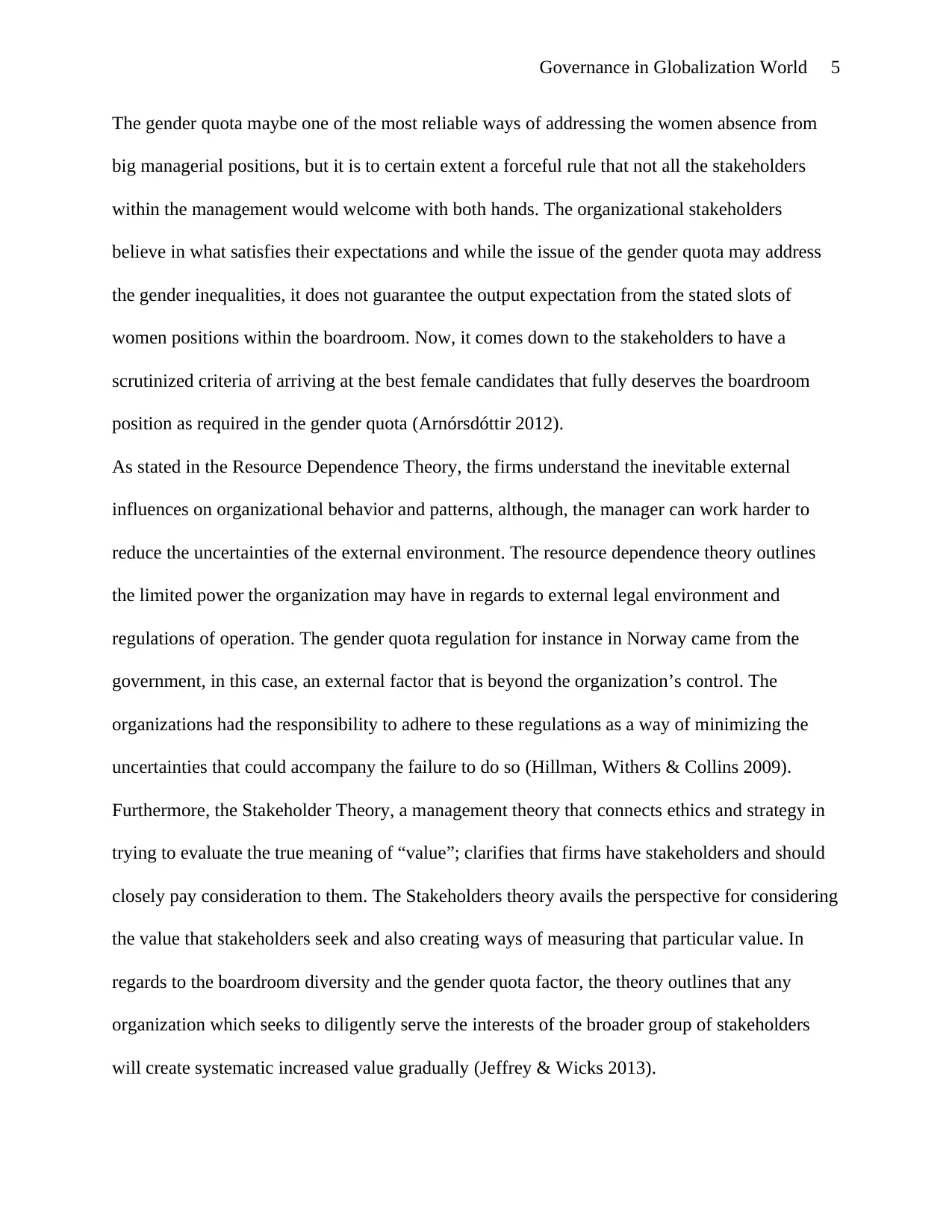
Governance in Globalization World 5
The gender quota maybe one of the most reliable ways of addressing the women absence from
big managerial positions, but it is to certain extent a forceful rule that not all the stakeholders
within the management would welcome with both hands. The organizational stakeholders
believe in what satisfies their expectations and while the issue of the gender quota may address
the gender inequalities, it does not guarantee the output expectation from the stated slots of
women positions within the boardroom. Now, it comes down to the stakeholders to have a
scrutinized criteria of arriving at the best female candidates that fully deserves the boardroom
position as required in the gender quota (Arnórsdóttir 2012).
As stated in the Resource Dependence Theory, the firms understand the inevitable external
influences on organizational behavior and patterns, although, the manager can work harder to
reduce the uncertainties of the external environment. The resource dependence theory outlines
the limited power the organization may have in regards to external legal environment and
regulations of operation. The gender quota regulation for instance in Norway came from the
government, in this case, an external factor that is beyond the organization’s control. The
organizations had the responsibility to adhere to these regulations as a way of minimizing the
uncertainties that could accompany the failure to do so (Hillman, Withers & Collins 2009).
Furthermore, the Stakeholder Theory, a management theory that connects ethics and strategy in
trying to evaluate the true meaning of “value”; clarifies that firms have stakeholders and should
closely pay consideration to them. The Stakeholders theory avails the perspective for considering
the value that stakeholders seek and also creating ways of measuring that particular value. In
regards to the boardroom diversity and the gender quota factor, the theory outlines that any
organization which seeks to diligently serve the interests of the broader group of stakeholders
will create systematic increased value gradually (Jeffrey & Wicks 2013).
The gender quota maybe one of the most reliable ways of addressing the women absence from
big managerial positions, but it is to certain extent a forceful rule that not all the stakeholders
within the management would welcome with both hands. The organizational stakeholders
believe in what satisfies their expectations and while the issue of the gender quota may address
the gender inequalities, it does not guarantee the output expectation from the stated slots of
women positions within the boardroom. Now, it comes down to the stakeholders to have a
scrutinized criteria of arriving at the best female candidates that fully deserves the boardroom
position as required in the gender quota (Arnórsdóttir 2012).
As stated in the Resource Dependence Theory, the firms understand the inevitable external
influences on organizational behavior and patterns, although, the manager can work harder to
reduce the uncertainties of the external environment. The resource dependence theory outlines
the limited power the organization may have in regards to external legal environment and
regulations of operation. The gender quota regulation for instance in Norway came from the
government, in this case, an external factor that is beyond the organization’s control. The
organizations had the responsibility to adhere to these regulations as a way of minimizing the
uncertainties that could accompany the failure to do so (Hillman, Withers & Collins 2009).
Furthermore, the Stakeholder Theory, a management theory that connects ethics and strategy in
trying to evaluate the true meaning of “value”; clarifies that firms have stakeholders and should
closely pay consideration to them. The Stakeholders theory avails the perspective for considering
the value that stakeholders seek and also creating ways of measuring that particular value. In
regards to the boardroom diversity and the gender quota factor, the theory outlines that any
organization which seeks to diligently serve the interests of the broader group of stakeholders
will create systematic increased value gradually (Jeffrey & Wicks 2013).
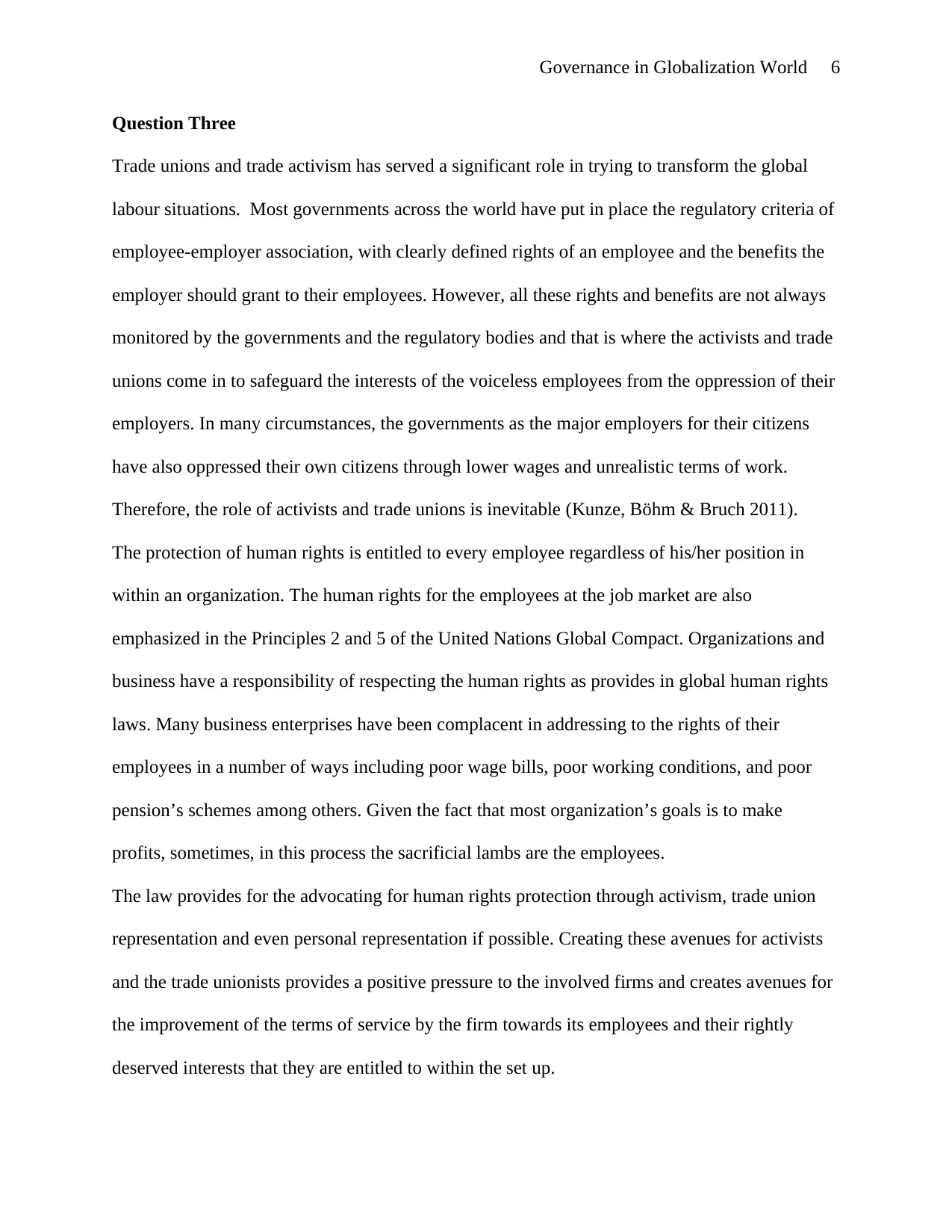
Governance in Globalization World 6
Question Three
Trade unions and trade activism has served a significant role in trying to transform the global
labour situations. Most governments across the world have put in place the regulatory criteria of
employee-employer association, with clearly defined rights of an employee and the benefits the
employer should grant to their employees. However, all these rights and benefits are not always
monitored by the governments and the regulatory bodies and that is where the activists and trade
unions come in to safeguard the interests of the voiceless employees from the oppression of their
employers. In many circumstances, the governments as the major employers for their citizens
have also oppressed their own citizens through lower wages and unrealistic terms of work.
Therefore, the role of activists and trade unions is inevitable (Kunze, Böhm & Bruch 2011).
The protection of human rights is entitled to every employee regardless of his/her position in
within an organization. The human rights for the employees at the job market are also
emphasized in the Principles 2 and 5 of the United Nations Global Compact. Organizations and
business have a responsibility of respecting the human rights as provides in global human rights
laws. Many business enterprises have been complacent in addressing to the rights of their
employees in a number of ways including poor wage bills, poor working conditions, and poor
pension’s schemes among others. Given the fact that most organization’s goals is to make
profits, sometimes, in this process the sacrificial lambs are the employees.
The law provides for the advocating for human rights protection through activism, trade union
representation and even personal representation if possible. Creating these avenues for activists
and the trade unionists provides a positive pressure to the involved firms and creates avenues for
the improvement of the terms of service by the firm towards its employees and their rightly
deserved interests that they are entitled to within the set up.
Question Three
Trade unions and trade activism has served a significant role in trying to transform the global
labour situations. Most governments across the world have put in place the regulatory criteria of
employee-employer association, with clearly defined rights of an employee and the benefits the
employer should grant to their employees. However, all these rights and benefits are not always
monitored by the governments and the regulatory bodies and that is where the activists and trade
unions come in to safeguard the interests of the voiceless employees from the oppression of their
employers. In many circumstances, the governments as the major employers for their citizens
have also oppressed their own citizens through lower wages and unrealistic terms of work.
Therefore, the role of activists and trade unions is inevitable (Kunze, Böhm & Bruch 2011).
The protection of human rights is entitled to every employee regardless of his/her position in
within an organization. The human rights for the employees at the job market are also
emphasized in the Principles 2 and 5 of the United Nations Global Compact. Organizations and
business have a responsibility of respecting the human rights as provides in global human rights
laws. Many business enterprises have been complacent in addressing to the rights of their
employees in a number of ways including poor wage bills, poor working conditions, and poor
pension’s schemes among others. Given the fact that most organization’s goals is to make
profits, sometimes, in this process the sacrificial lambs are the employees.
The law provides for the advocating for human rights protection through activism, trade union
representation and even personal representation if possible. Creating these avenues for activists
and the trade unionists provides a positive pressure to the involved firms and creates avenues for
the improvement of the terms of service by the firm towards its employees and their rightly
deserved interests that they are entitled to within the set up.
⊘ This is a preview!⊘
Do you want full access?
Subscribe today to unlock all pages.

Trusted by 1+ million students worldwide
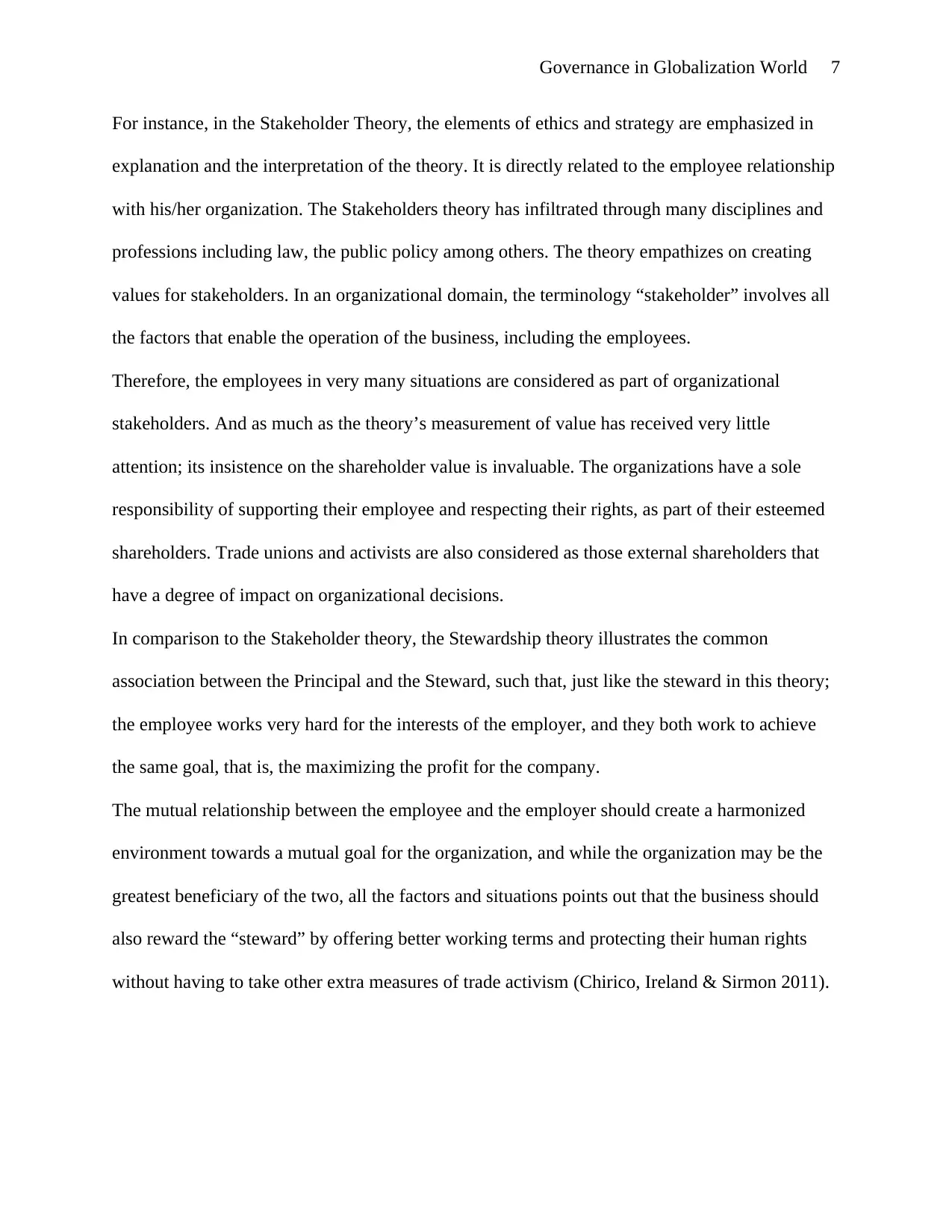
Governance in Globalization World 7
For instance, in the Stakeholder Theory, the elements of ethics and strategy are emphasized in
explanation and the interpretation of the theory. It is directly related to the employee relationship
with his/her organization. The Stakeholders theory has infiltrated through many disciplines and
professions including law, the public policy among others. The theory empathizes on creating
values for stakeholders. In an organizational domain, the terminology “stakeholder” involves all
the factors that enable the operation of the business, including the employees.
Therefore, the employees in very many situations are considered as part of organizational
stakeholders. And as much as the theory’s measurement of value has received very little
attention; its insistence on the shareholder value is invaluable. The organizations have a sole
responsibility of supporting their employee and respecting their rights, as part of their esteemed
shareholders. Trade unions and activists are also considered as those external shareholders that
have a degree of impact on organizational decisions.
In comparison to the Stakeholder theory, the Stewardship theory illustrates the common
association between the Principal and the Steward, such that, just like the steward in this theory;
the employee works very hard for the interests of the employer, and they both work to achieve
the same goal, that is, the maximizing the profit for the company.
The mutual relationship between the employee and the employer should create a harmonized
environment towards a mutual goal for the organization, and while the organization may be the
greatest beneficiary of the two, all the factors and situations points out that the business should
also reward the “steward” by offering better working terms and protecting their human rights
without having to take other extra measures of trade activism (Chirico, Ireland & Sirmon 2011).
For instance, in the Stakeholder Theory, the elements of ethics and strategy are emphasized in
explanation and the interpretation of the theory. It is directly related to the employee relationship
with his/her organization. The Stakeholders theory has infiltrated through many disciplines and
professions including law, the public policy among others. The theory empathizes on creating
values for stakeholders. In an organizational domain, the terminology “stakeholder” involves all
the factors that enable the operation of the business, including the employees.
Therefore, the employees in very many situations are considered as part of organizational
stakeholders. And as much as the theory’s measurement of value has received very little
attention; its insistence on the shareholder value is invaluable. The organizations have a sole
responsibility of supporting their employee and respecting their rights, as part of their esteemed
shareholders. Trade unions and activists are also considered as those external shareholders that
have a degree of impact on organizational decisions.
In comparison to the Stakeholder theory, the Stewardship theory illustrates the common
association between the Principal and the Steward, such that, just like the steward in this theory;
the employee works very hard for the interests of the employer, and they both work to achieve
the same goal, that is, the maximizing the profit for the company.
The mutual relationship between the employee and the employer should create a harmonized
environment towards a mutual goal for the organization, and while the organization may be the
greatest beneficiary of the two, all the factors and situations points out that the business should
also reward the “steward” by offering better working terms and protecting their human rights
without having to take other extra measures of trade activism (Chirico, Ireland & Sirmon 2011).
Paraphrase This Document
Need a fresh take? Get an instant paraphrase of this document with our AI Paraphraser
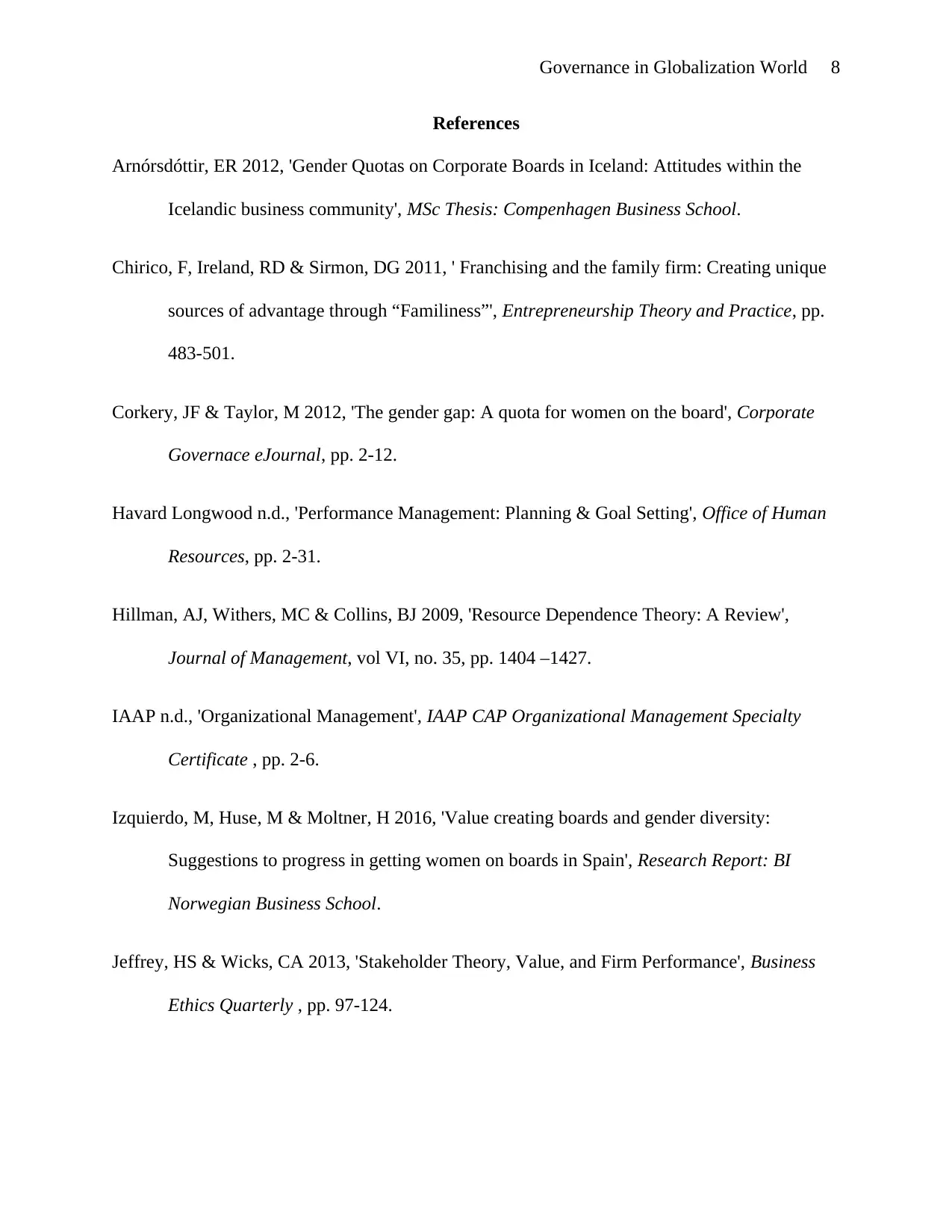
Governance in Globalization World 8
References
Arnórsdóttir, ER 2012, 'Gender Quotas on Corporate Boards in Iceland: Attitudes within the
Icelandic business community', MSc Thesis: Compenhagen Business School.
Chirico, F, Ireland, RD & Sirmon, DG 2011, ' Franchising and the family firm: Creating unique
sources of advantage through “Familiness”', Entrepreneurship Theory and Practice, pp.
483-501.
Corkery, JF & Taylor, M 2012, 'The gender gap: A quota for women on the board', Corporate
Governace eJournal, pp. 2-12.
Havard Longwood n.d., 'Performance Management: Planning & Goal Setting', Office of Human
Resources, pp. 2-31.
Hillman, AJ, Withers, MC & Collins, BJ 2009, 'Resource Dependence Theory: A Review',
Journal of Management, vol VI, no. 35, pp. 1404 –1427.
IAAP n.d., 'Organizational Management', IAAP CAP Organizational Management Specialty
Certificate , pp. 2-6.
Izquierdo, M, Huse, M & Moltner, H 2016, 'Value creating boards and gender diversity:
Suggestions to progress in getting women on boards in Spain', Research Report: BI
Norwegian Business School.
Jeffrey, HS & Wicks, CA 2013, 'Stakeholder Theory, Value, and Firm Performance', Business
Ethics Quarterly , pp. 97-124.
References
Arnórsdóttir, ER 2012, 'Gender Quotas on Corporate Boards in Iceland: Attitudes within the
Icelandic business community', MSc Thesis: Compenhagen Business School.
Chirico, F, Ireland, RD & Sirmon, DG 2011, ' Franchising and the family firm: Creating unique
sources of advantage through “Familiness”', Entrepreneurship Theory and Practice, pp.
483-501.
Corkery, JF & Taylor, M 2012, 'The gender gap: A quota for women on the board', Corporate
Governace eJournal, pp. 2-12.
Havard Longwood n.d., 'Performance Management: Planning & Goal Setting', Office of Human
Resources, pp. 2-31.
Hillman, AJ, Withers, MC & Collins, BJ 2009, 'Resource Dependence Theory: A Review',
Journal of Management, vol VI, no. 35, pp. 1404 –1427.
IAAP n.d., 'Organizational Management', IAAP CAP Organizational Management Specialty
Certificate , pp. 2-6.
Izquierdo, M, Huse, M & Moltner, H 2016, 'Value creating boards and gender diversity:
Suggestions to progress in getting women on boards in Spain', Research Report: BI
Norwegian Business School.
Jeffrey, HS & Wicks, CA 2013, 'Stakeholder Theory, Value, and Firm Performance', Business
Ethics Quarterly , pp. 97-124.
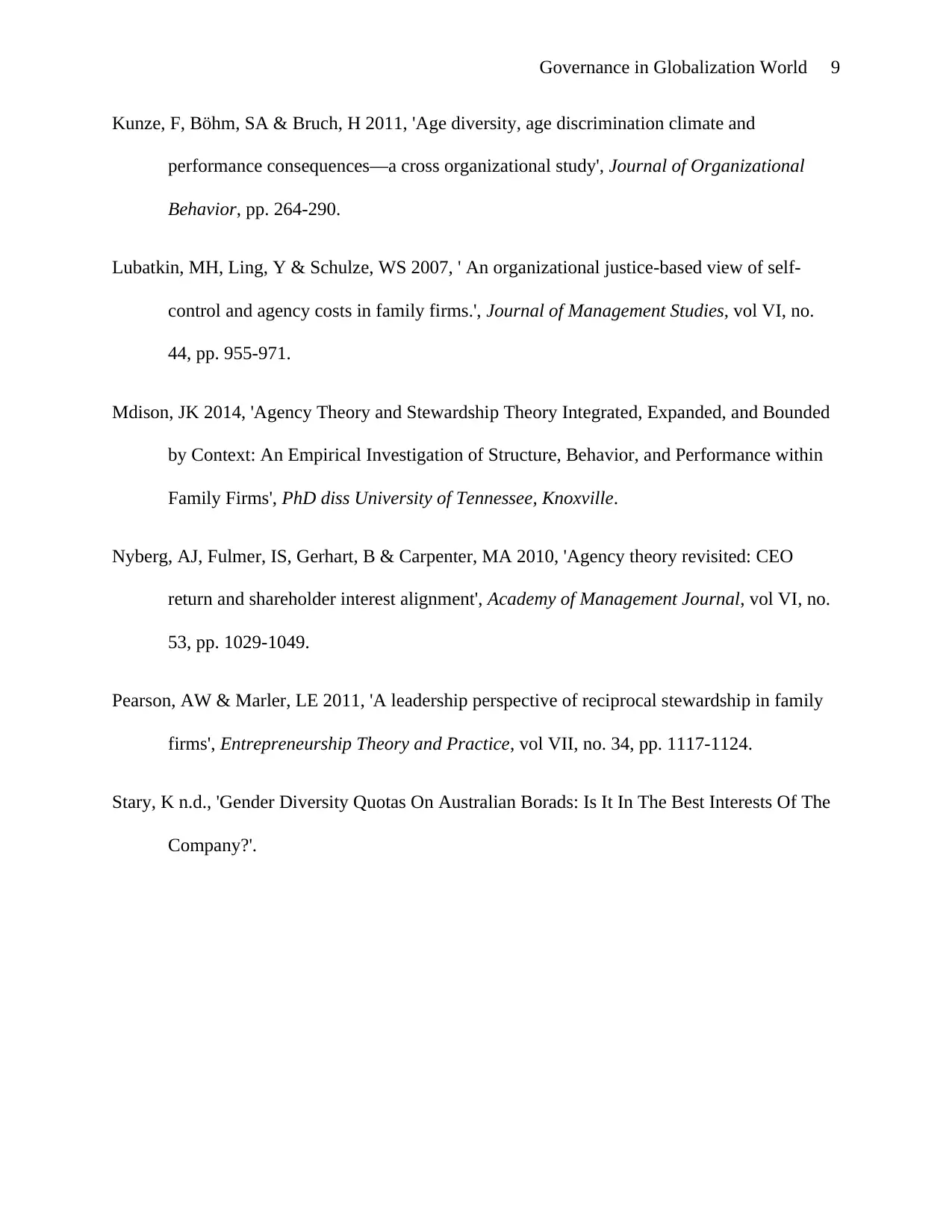
Governance in Globalization World 9
Kunze, F, Böhm, SA & Bruch, H 2011, 'Age diversity, age discrimination climate and
performance consequences—a cross organizational study', Journal of Organizational
Behavior, pp. 264-290.
Lubatkin, MH, Ling, Y & Schulze, WS 2007, ' An organizational justice-based view of self-
control and agency costs in family firms.', Journal of Management Studies, vol VI, no.
44, pp. 955-971.
Mdison, JK 2014, 'Agency Theory and Stewardship Theory Integrated, Expanded, and Bounded
by Context: An Empirical Investigation of Structure, Behavior, and Performance within
Family Firms', PhD diss University of Tennessee, Knoxville.
Nyberg, AJ, Fulmer, IS, Gerhart, B & Carpenter, MA 2010, 'Agency theory revisited: CEO
return and shareholder interest alignment', Academy of Management Journal, vol VI, no.
53, pp. 1029-1049.
Pearson, AW & Marler, LE 2011, 'A leadership perspective of reciprocal stewardship in family
firms', Entrepreneurship Theory and Practice, vol VII, no. 34, pp. 1117-1124.
Stary, K n.d., 'Gender Diversity Quotas On Australian Borads: Is It In The Best Interests Of The
Company?'.
Kunze, F, Böhm, SA & Bruch, H 2011, 'Age diversity, age discrimination climate and
performance consequences—a cross organizational study', Journal of Organizational
Behavior, pp. 264-290.
Lubatkin, MH, Ling, Y & Schulze, WS 2007, ' An organizational justice-based view of self-
control and agency costs in family firms.', Journal of Management Studies, vol VI, no.
44, pp. 955-971.
Mdison, JK 2014, 'Agency Theory and Stewardship Theory Integrated, Expanded, and Bounded
by Context: An Empirical Investigation of Structure, Behavior, and Performance within
Family Firms', PhD diss University of Tennessee, Knoxville.
Nyberg, AJ, Fulmer, IS, Gerhart, B & Carpenter, MA 2010, 'Agency theory revisited: CEO
return and shareholder interest alignment', Academy of Management Journal, vol VI, no.
53, pp. 1029-1049.
Pearson, AW & Marler, LE 2011, 'A leadership perspective of reciprocal stewardship in family
firms', Entrepreneurship Theory and Practice, vol VII, no. 34, pp. 1117-1124.
Stary, K n.d., 'Gender Diversity Quotas On Australian Borads: Is It In The Best Interests Of The
Company?'.
⊘ This is a preview!⊘
Do you want full access?
Subscribe today to unlock all pages.

Trusted by 1+ million students worldwide
1 out of 9
Related Documents
Your All-in-One AI-Powered Toolkit for Academic Success.
+13062052269
info@desklib.com
Available 24*7 on WhatsApp / Email
![[object Object]](/_next/static/media/star-bottom.7253800d.svg)
Unlock your academic potential
Copyright © 2020–2025 A2Z Services. All Rights Reserved. Developed and managed by ZUCOL.





